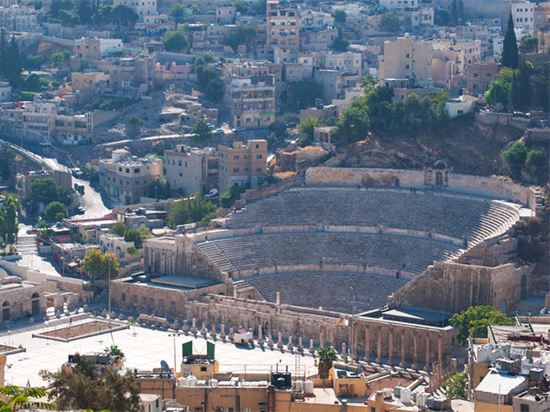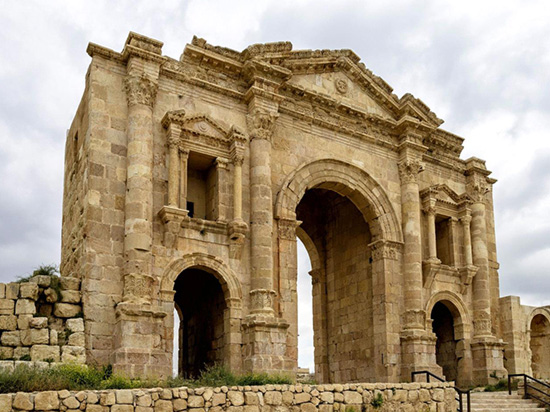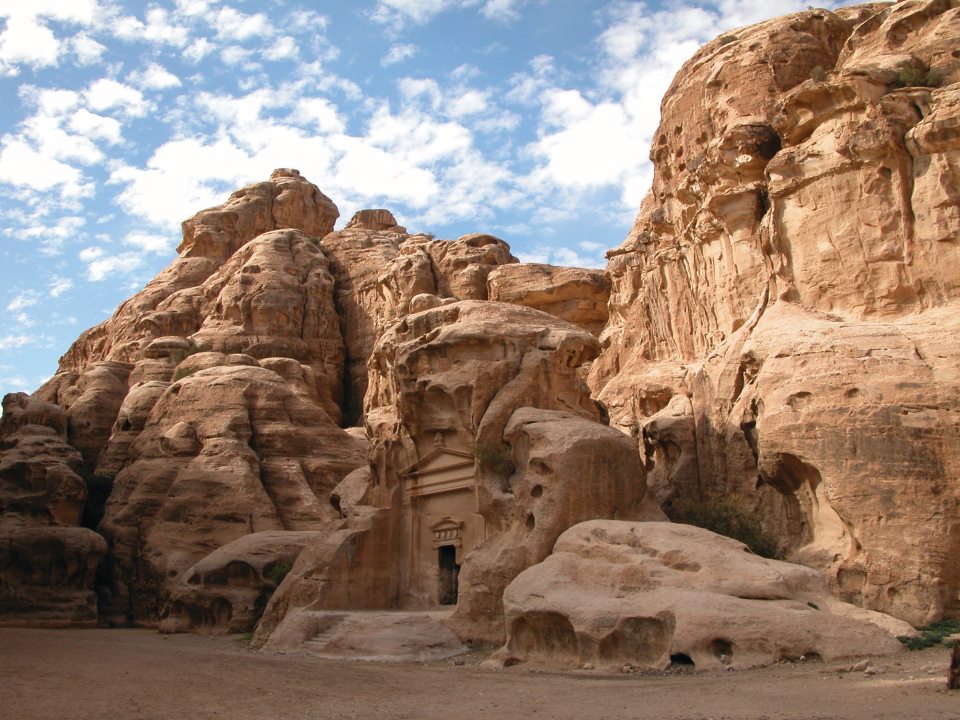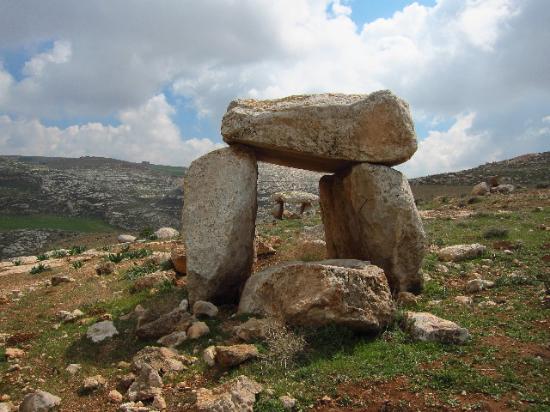Amman
Amman the capital of Jordan is a city which geographically straddles seven hills and historically sits astride many centuries.
The city's modern buildings blend with the remnants of ancient civilizations. The profusion of gleaming white houses, kebab stalls with roasting meat, and tiny cafes where rich Arabian coffee is sipped in the afternoon sunshine, conjure a mood straight from a thousand and one nights. It is a city with a timeless ambiance, where a slight detour off the beaten track reveals the wonders of a Bronze Age settlement or a Byzantine monastery. .In its souqs (markets), you can bargain for fruit, perfume, gold or other exquisite luxuries of the Middle East.
For Businessmen, Amman offers the most up-to-date convention and communication facilities. Its strategic position and convivial atmosphere, make it one of the foremost centers of finance & trade in the Middle East today Roman Theater: This magnificently restored theatre is the most obvious and impressive remnant of Roman Philadelphia, and is the highlight of Amman for most foreign visitors. The theatre itself is cut into the northern side of a hill, and has a seating capacity of 6000. The best time for photographs is the morning, when the light is soft � although the views from the top tiers just before sunset are also superb. The theatre was probably built in the 2nd century AD during the reign of Antoninus Pius (AD 138�61). It was built on three tiers: the rulers, of course, sat closest to the action, the military secured the middle section, and the general public perched and squinted from the top rows. Theatres often had religious significance, and the small shrine above the top row of seats once housed a statue of the goddess Athena (now in the Jordan Museum), who was prominent in the religious life of the city. Full restoration of the theatre began in 1957. Unfortunately, non-original materials were used, which means that the present reconstruction is partly inaccurate. However, the final product is certainly impressive, especially considering that the theatre has again become a place of entertainment in recent years. Concerts are sometimes put on here in the summer� check with the tourist office or ask at your hotel.
Attractiomns:
Citadel Mount: he area known as the Citadel sits on the highest hill in Amman, Jebel Al Qala�a (about 850m above sea level), and is the site of ancient Rabbath-Ammon. Occupied since the Bronze Age, it's surrounded by a 1700m-long wall, which was rebuilt many times during the Bronze and Iron Ages, as well as the Roman, Byzantine and Umayyad periods. There's plenty to see, but the Citadel's most striking sights are the Temple of Hercules and the Ummayad Palace. Artefacts dating from the Bronze Age show that the hill was a fortress and/or agora (open space for commerce and politics) for thousands of years. The two giant standing pillars are the remains of the Roman Temple of Hercules. Once connected to the Forum (downtown), the temple was built during the reign of Roman Emperor Marcus Aurelius (AD 161�80). The only obvious remains are parts of the podium and the columns, which are visible from around town. There�s also a rather touching remnant of a stone-carved hand, which shows the level of detail that would have adorned the temple in its glory days. Nearby is a lookout with sweeping views of the downtown area. The Citadel�s most impressive series of historic buildings is focused around the Umayyad Palace, behind the small (and rather old-fashioned) archaeological museum. Believed to be the work of Umayyad Arabs and dating from about AD 720, the palace was an extensive complex of royal and residential buildings and was once home to the governor of Amman. Its lifespan was short � it was destroyed by an earthquake in AD 749 and was never fully rebuilt. Coming from the south, the first major building belonging to the palace complex is the domed audience hall, designed to impress visitors to the royal palace. The most intact of the buildings on the site, the hall is shaped like a cross, mirroring the Byzantine church over which it was built. After much debate as to whether the central space had originally been covered or left open to the elements, consensus came down on the side of the ceiling dome, which was reconstructed by Spanish archaeologists. A courtyard immediately north of the hall leads to a 10m-wide colonnaded street, lined with numerous arches and columns, and flanked by residential and administrative buildings. Further to the north is the former governor�s residence, which includes the throne room. East of the audience hall is the Umayyad Cistern, an enormous circular hole with steps leading down to the bottom, which once supplied water to the palace and surrounding areas. The small disc on the floor in the centre once supported a pillar that was used for measuring water levels. Near the museum to the south is the small Byzanrine Basillica, most of which has been destroyed by earthquakes. It dates from the 6th or 7th century AD, and contains a few dusty mosaics. The only access roads to the Citadel are from Al Malek Ali Bin Al Hussein St. It�s better to hire a taxi for the trip up (around JD1 from downtown) and save some energy for the recommended walk down. Steps lead from east of the Citadel complex, past a viewing platform to Hashemi St, opposite the
Roman Theatre. This makes a fine start to a walking tour of downtown.
Jordan Museum: The Jordan Museum, located next to the City Hall, is one of the best in the Middle East. Housed in a grand modern building, a series of beautifully presented and informative displays tell Jordan's historical epic from the first people through the Nabataean civilisation to the cusp of the modern era. Highlights include the oldest-known human statues (the spookily modern 9500-year-old plaster mannequins of Ain Ghazal), Jordan's share of the Dead Sea Scrolls, and a host of remains from Petra and surrounds.
Darrat Al Funnon: On the hillside to the north of the downtown area, this cultural haven is dedicated to contemporary art. The main building features an excellent art gallery with works by Jordanian and other Arab artists, an art library, and workshops for Jordanian and visiting sculptors and painters. A schedule of upcoming exhibitions, lectures, films and public discussion forums is available on the website. Almost as significant as the centre�s artistic endeavours are the architectural features of the site. At the base of the complex, near the entrance, are the excavated ruins of a 6th-century Byzantine church. Buildings further up the hill are mostly restored residences from the 1920s in the lovely Mediterranean-Venetian style that was popular in the region in the 1920s. There is also a peaceful cafe and gardens with views over Amman. Access is easiest on foot. From near the southern end of Al Malek Al Hussein St, head up the stairs under the �Riviera Hotel� sign. At the top of the stairs, turn immediately right onto Nimer Bin Adwan St and walk uphill for 50m where you need to take the left fork. The entrance gate (no English sign) is on the right after a few metres.
Royal Automobile Museum: You really don't have to be a car enthusiast to enjoy this museum, which displays more than 70 classic cars and motorbikes from the personal collection of King Hussein. It's something of a gem, and a great way to recount the story of modern Jordan. Vehicles range from pre-1950s glories to modern sports cars, taking in chrome-clad American cruisers to regal Rolls-Royces along the way, with accounts of presidential visits, Hollywood stars and defunct Middle Eastern monarchies enlivening the narrative. The final display of suitably dusty rally cars is a neat rejoinder to the polish and chrome of the rest of the vehicles, while outside Matt Damon's ruggedly cool Martian rover from The Martian (filmed in Wadi Rum) gives a vision of possible future road trips. The museum is in the northwestern suburbs, north of 8th Circle.
King Abdullah Mosque: Close to the Jordanian Parliament, capped by a beautiful blue, mosaic dome, is one of the most famous and most recognizable structures in Amman: the King Abdullah Mosque. It was built by the late King Hussein between 1982 and 1990 � as a memorial to his grandfather and can accommodate thousands of worshipers. An Islamic museum is located within the mosque. As a reflection of the city�s cosmopolitan character, it is very close to a Coptic church.
















